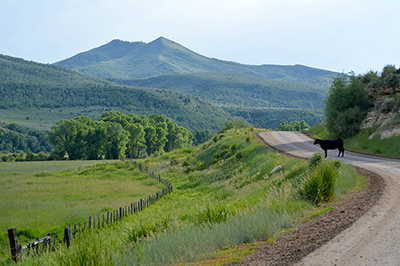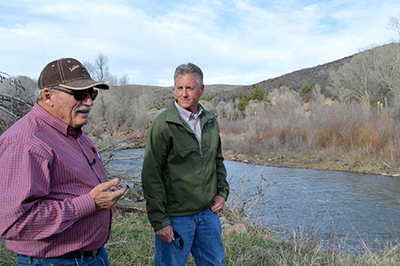
In the late ‘90s, southern Wyoming’s Battle Creek was living up to its name: it was waging a turf war with second-generation rancher George Salisbury Jr.’s hay fields.
Salisbury and his wife, Laura, were owners and operators of the Ladder Livestock Company, a cattle and sheep operation employing rotational grazing practices across a patchwork of private, state and federally owned lands. Nestled in the Little Snake River Valley along the Wyoming/Colorado line, the ranch uses water from Battle Creek, a tributary of the Little Snake River.
Over the years Battle Creek had shown a tendency to wander; now, the stream was threatening to destroy the hay it irrigated, a crop essential for feeding Salisbury’s livestock during winter months. Salisbury had tried various methods to keep the creek in check — building dams or adjusting the stream’s banks to direct the flow to a more preferred pattern, for example — but nothing really worked.
Battle Creek was going its own way, and Salisbury was stumped.
Meanwhile, elsewhere in Wyoming, U.S. Fish and Wildlife Service biologist Mark Hogan was fighting a very different battle: training himself to drink coffee.
As the state coordinator for Wyoming’s Partners Program, Hogan’s job and passion is bringing people together to do good things for wildlife. His business model is simple: focus on the most important habitats for wildlife, learn what the landowners living and working in the area want and need from the land, then build a working relationship. The end result is win-wins for people and animals.
“The philosophy of the Partners Program has always been, ‘Where can we help? What can the land do, and what do you want it to do?’” Hogan said.
Hogan discovered this type of conversation can start over breakfast and a hot cup of coffee with neighbors. Coffee, he said, is “an invention that brings people together.” He learned to drink it.
In Wyoming, where the Rocky Mountains meet the Great Plains, the landscape is characterized by sagebrush uplands, grassy prairies and soaring peaks. Eighty-five percent of the state is considered rangelands, and domestic livestock production is an important component of the state’s cultural identity and $2.04 billion agricultural industry.
At the same time, water here is scarce. An estimated 2 to 3 percent of wet meadows and riparian areas comprise the state, making Wyoming the third-driest in the nation. All the state’s inhabitants, human and otherwise, value Wyoming’s wet meadows, streams and rivers.
The majority are on private rangelands, which makes ranching families the guardians of much of the state’s water resources.
Hogan recognized his ranching neighbors were in a unique position to make a difference for native fish species in decline, such as the Colorado cutthroat trout. He also knew that if one of these species reached the point where it required federal protection under the Endangered Species Act, a listing could have an impact on local agricultural practices.

“The lifeblood of a ranch is its water,” Hogan said, “and like our birds, our fish are migratory. They have to be able to move up and down a [river] system to find the right conditions to complete their life cycles.”
Part of his job was to ensure those fish could migrate, and that meant restoring and stabilizing streams. With a clear focus on improving Wyoming’s water resources for people and wildlife, Hogan embarked on a journey that would guide his career for decades and bring him to Ladder Ranch.
Through a network of conservation-minded friends and partners, Hogan met Salisbury, who invited him to Ladder Ranch to survey Battle Creek.
What Hogan saw was a body of water responding to change. “As a stream goes downhill, you want it to flatten out and meander so that it can dissipate energy,” he said. Straightening Battle Creek upstream was causing it meander downstream, and these new meanders were affecting Salisbury’s crops.
Hogan saw a chance to make some needed corrections. “We can use a stream’s tendencies to heal itself, so that was our strategy,” he said.
If they could modify the flow patterns of Battle Creek to get the stream to a stable state, they could not only save Salisbury’s hay fields but also improve fish passage for the Colorado cutthroat trout and other native fishes.
With Salisbury’s approval, Hogan got busy. Joining him were the Wyoming Game and Fish Department, Trout Unlimited and the Natural Resources Conservation Service’s Little Snake River Conservation District.
Their corrections were simple. They built cross vanes of rock, structures that deflected water flow from the creek’s banks, thereby preventing the stream’s edges from scouring. They also created fish passages so fish could migrate. The work was complete in 2000.
Salisbury got to enjoy the changes for a decade. He died in 2010 at age 89. Now, his daughter, Sharon O’Toole, carries on her father’s legacy and his love of the land. She oversees Ladder Ranch with her husband, Pat, and two of their children, Meghan and Eamon.
“For somebody like Mark to show up at my father’s door was really a gift,” O’Toole said. “My father was always a range-management guy. He’d manage the range just as much as he did his livestock. One thing he’d say is, ‘Landscape is too important to be managed generically, it must be managed specifically.’”
Their work continues paying benefits to the land and all of its stewards in the Little Snake River Valley, O’Toole said. “Our project really protects the banks and the creek from erosion during times of high water, and that keeps the soil from going downstream,” she said. “It matters; it makes a difference.”
Today, the Little Snake River Valley watershed is home to the largest fish passage project in the United States. The Service, Ladder Ranch and its neighbors, and an array of public and private partners are working to keep it that way, continuing to improve stream banks, wetlands, irrigation systems and wildlife habitat in the area.
“There was some pioneering work that was done at Ladder Ranch in particular that we now use as commonplace,” Hogan said.
But the O’Tooles’ conservation contributions don’t end at Battle Creek’s banks. The family is engaged in official, voluntary agreements under the Endangered Species Act that provide benefits to the greater sage-grouse in the nearby sagebrush uplands.
“There are so many projects you can work on with the same people for a long period of time that you build these incredible relationships,” Hogan said. “You get to know the families because you’re working with them long-term on projects that require surveying, designing, coming back to stake it out, and then construction.
“In any given year you may stay with a landowner for a full three weeks, so you become kind of like those in-laws that just ... show up!”
A federal biologist and honorary in-law? Now there’s a unique role.
“We’ve known Mark so long it seems like forever,” said O’Toole. “He just has the perfect personality for the job -- great people skills, and he really knows his stuff. It took Mark and the Partners Program to bring things into focus and get something major done.”
It also took one man willing to boldly go where he had not gone before – to gulp down a steaming cup of coffee.
 Sign In
Sign In
 Sign In
Sign In
